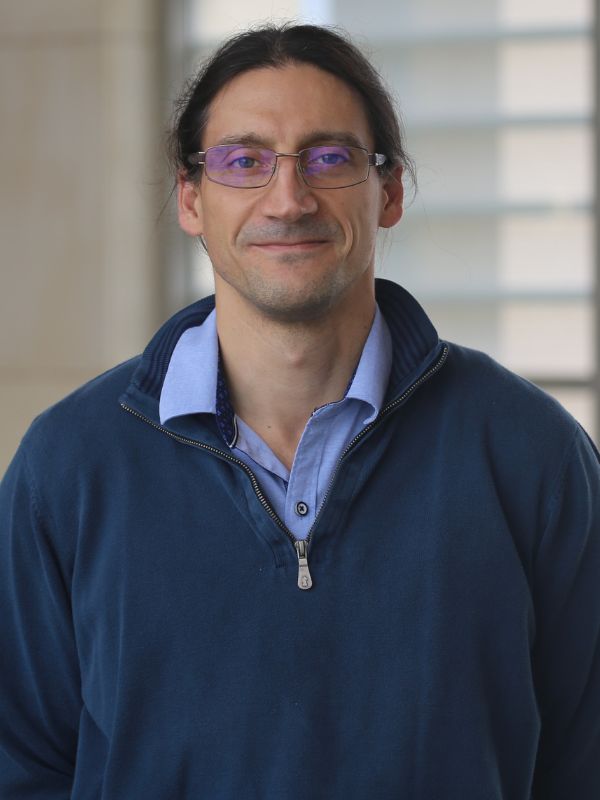Biography
Joined the Department in 2020
Associations:
- Visiting Professor, Faculty of Life Sciences, Universidad Andrés Bello, Chile
Research Interests
Clostridioides difficile spore-host interactions, exosporium assembly and therapeutic development.
Clostridioides difficile is a Gram positive, strictly anaerobic, spore-forming bacterium that causes C. difficile infections (CDI) and is considered as the most frequent hospital-acquired pathogen. With nearly 500,000 cases per year, CDI cause major economic burden to the United States Health Care System. Although standard of care treatments resolve CDI in most cases, a significant proportion of CDI-treated patients (~30%) will experiment a recurrence of the disease with aggravated symptoms. Given that C. difficile is an urgent threat to human health, our group is addressing several independent, and complementary research avenues:
- Mechanisms of C. difficile spore-host interactions. During the infection, C. difficile initiates a sporulation cycle that leads to the formation of new dormant spores in the host, which are key for the recurrence and transmission of the disease. However, the mechanisms that underline C. difficile spore-persistence remain unclear. Our aim is to elucidate how C. difficile spores interact with the intestinal mucosa and persist during the infection. To accomplish this aim, we blend expertise from bacterial genetics, cellular microbiology, cellular biology and advance imaging techniques.
- Exosporium assembly mechanisms of C. difficile spores. The surface of C. difficile spores serves as the primary site of interaction with host surfaces. A major obstacle to develop therapies that remove C. difficile spores from the host and/or environment is the lack of basic understanding of how C. difficile forms the outer exosporium layer of the spore. Our aim is to understand how exosporium assembly occurs during C. difficile spore-formation. To dissect the basis underlying exosporium assembly we use molecular biology, bacterial genetics, biochemical and structural analysis, omics and single cell imaging techniques to understand the mechanisms through which key morphogenetic proteins drive exosporium assembly and interplay with other spore-coat and exosporium constituents.
- Therapeutic development against C. difficile infections. No effective antibiotic and/or vaccine is readily available to resolve CDI and prevent recurrence and transmission of the disease. By understanding how C. difficile interacts with the host and the composition of the spore surface layer, we aim to develop novel therapeutic strategies that prevent C. difficile spore´s interaction with the host´s intestinal mucosa and their persistence during disease. To accomplish these aims we blend knowledge from immune-proteomics and immunology, pharmacology and nanotechnology to design novel alternatives to combat CDI and prevent recurrence and transmission of the disease.
In order to contribute to the control of COVID-19 spread world-wide, we are adapting a protein-display platform, which we have recently used for nasal immunization against C. difficile infections, to express SARS-CoV-2 surface proteins for mucosal immunization studies.
Laboratory Details
Laboratory Address:Interdisciplinary Life Sciences Building
Room 3213
979-847-5689
Educational Background
- Food Engineering, Universidad Austral de Chile, Chile, 2002
- Ph.D., Oregon State University, 2009
- Post-Doctoral training, Department of Biomedical Sciences, Oregon State University, 2011
- Previous Faculty Appointments: Universidad Andrés Bello
Selected Publications
- Paredes-Sabja, D, Pizarro-Guajardo, M, Sorg, JA. Editorial: Pathogenic clostridia. Anaerobe. 2024;90 :102911. doi: 10.1016/j.anaerobe.2024.102911. PubMed PMID:39284521 .
- Romero-Rodríguez, A, Ruíz-Villafán, B, Sánchez, S, Paredes-Sabja, D. Is there a role for intestinal sporobiota in the antimicrobial resistance crisis?. Microbiol Res. 2024;288 :127870. doi: 10.1016/j.micres.2024.127870. PubMed PMID:39173554 .
- Queraltó, C, Ortega, C, Díaz-Yáñez, F, Inostroza, O, Espinoza, G, Álvarez, R et al.. The chaperone ClpC participates in sporulation, motility, biofilm, and toxin production of Clostridioides difficile. J Glob Antimicrob Resist. 2023;33 :328-336. doi: 10.1016/j.jgar.2023.05.004. PubMed PMID:37211213 .
- Castro-Córdova, P, Otto-Medina, M, Montes-Bravo, N, Brito-Silva, C, Lacy, DB, Paredes-Sabja, D et al.. Redistribution of the Novel Clostridioides difficile Spore Adherence Receptor E-Cadherin by TcdA and TcdB Increases Spore Binding to Adherens Junctions. Infect Immun. 2023;91 (1):e0047622. doi: 10.1128/iai.00476-22. PubMed PMID:36448839 PubMed Central PMC9872679.
- Montes-Bravo, N, Romero-Rodríguez, A, García-Yunge, J, Medina, C, Pizarro-Guajardo, M, Paredes-Sabja, D et al.. Role of the Spore Coat Proteins CotA and CotB, and the Spore Surface Protein CDIF630_02480, on the Surface Distribution of Exosporium Proteins in Clostridioides difficile 630 Spores. Microorganisms. 2022;10 (10):. doi: 10.3390/microorganisms10101918. PubMed PMID:36296193 PubMed Central PMC9610443.
- Camargo, A, Guerrero-Araya, E, Castañeda, S, Vega, L, Cardenas-Alvarez, MX, Rodríguez, C et al.. Intra-species diversity of Clostridium perfringens: A diverse genetic repertoire reveals its pathogenic potential. Front Microbiol. 2022;13 :952081. doi: 10.3389/fmicb.2022.952081. PubMed PMID:35935202 PubMed Central PMC9354469.
- Castro-Córdova, P, Mora-Uribe, P, Reyes-Ramírez, R, Cofré-Araneda, G, Orozco-Aguilar, J, Brito-Silva, C et al.. Author Correction: Entry of spores into intestinal epithelial cells contributes to recurrence of Clostridioides difficile infection. Nat Commun. 2022;13 (1):2465. doi: 10.1038/s41467-022-30283-x. PubMed PMID:35487940 PubMed Central PMC9054739.
- Paredes-Sabja, D, Cid-Rojas, F, Pizarro-Guajardo, M. Assembly of the exosporium layer in Clostridioides difficile spores. Curr Opin Microbiol. 2022;67 :102137. doi: 10.1016/j.mib.2022.01.008. PubMed PMID:35182899 .
- Castro-Córdova, P, Mendoza-León, MJ, Paredes-Sabja, D. Using a ligate intestinal loop mouse model to investigate Clostridioides difficile adherence to the intestinal mucosa in aged mice. PLoS One. 2021;16 (12):e0261081. doi: 10.1371/journal.pone.0261081. PubMed PMID:34936648 PubMed Central PMC8694449.
- Guerrero-Araya, E, Muñoz, M, Rodríguez, C, Paredes-Sabja, D. FastMLST: A Multi-core Tool for Multilocus Sequence Typing of Draft Genome Assemblies. Bioinform Biol Insights. 2021;15 :11779322211059238. doi: 10.1177/11779322211059238. PubMed PMID:34866905 PubMed Central PMC8637782.

